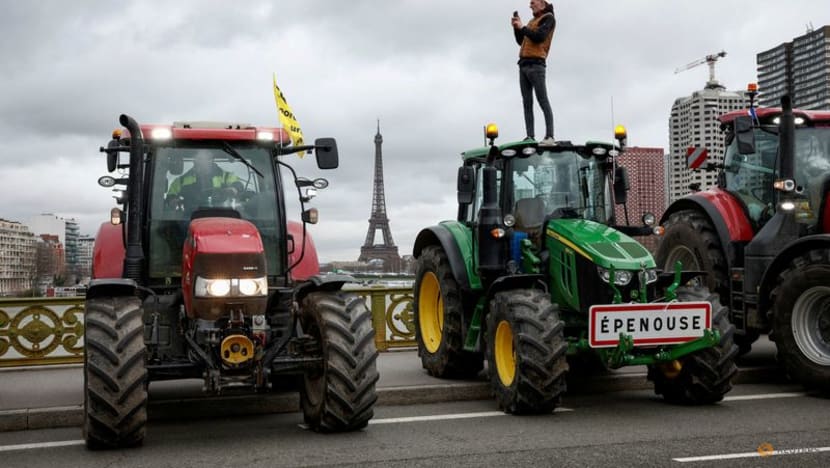Farmers in Europe, India demand for greater government support with sector facing rising costs, climate pressures
Adding to the complexities are considerations such as the broader goal of a regional bloc in Europe, and an upcoming election in India.


This audio is generated by an AI tool.
Farmers around the world are calling for governments to provide more help for their sector, as they increasingly struggle to make ends meet.
There have been mass demonstrations taking place from Europe to India, as an industry struck by rising costs and dwindling earnings seeks to make its voice heard.
The sector is also especially vulnerable to the impacts of climate change, and has been caught up in the green transition.
Adding to the complexities are considerations such as the broader goal of a regional bloc in Europe, and an upcoming election in India.
PRESERVING ITALIAN FARMING HERITAGE
Compared to some of their European neighbours, many of the farmers’ protests in Italy are smaller, spontaneous, and not controlled by a central organisation.
Italy has a long and proud farming history, and there are currently more than a million farms in the country. However, that number is dropping rapidly, with two-thirds of farms having closed since the 1980s.
Some of the most famous produce in the world come from the country, including wheat used to make pasta flour, and the olives used to create olive oil.
Many farmers say they are fighting not just for their own livelihoods, but the culture and traditions of Italy itself.
Some are calling for a radical overhaul of the whole Italian agricultural system.
"At the moment, the farmer is an entrepreneur like everyone else. Somehow, they have to chase after the market to sell their product. But we are not selling a luxury item. We are selling a necessity, so we should remove a large part of the agricultural sector from market logic,” Mr Giacomo Lepri, a farmer under the Coraggio agricultural co-operative, told CNA.
The Coraggio agricultural co-operative took over some plots of abandoned land on the outskirts of Rome nine years ago. It has transformed them, and helped the local community by creating jobs and promoting sustainable farming practices.
However, the government is unlikely to take such bold measures, although they are working hard to be seen as pro-farming. For instance, the Italian parliament has passed a law recognising farmers as guardians of the environment and the territory.
But many blame the policies coming from the European Union (EU).
Cheaper produce from Ukraine has been flooding the market, as the European Commission had committed to help the war-torn country by waiving duties for all Ukrainian food imports.
Environmental measures within the EU’s Green Deal, designed to try and fight climate change, have been seen as detrimental by farmers.
Farmer Danilo Scenna, who owns DS Bio farm located midway between Rome and Naples, said that new measures have to be adopted in the face of climate change, such as using natural fertilisers.
"I started this work only 12 years ago. In agriculture, 12 years is a fraction of a second. It's really a very, very short time. In 12 years, I have truly seen the effects of climate change. Every season is different from the other and we must try to find new strategies to counteract the effects of climate change,” he told CNA.
However, many larger farmers disagree with him, saying that in Italy’s incredibly diverse agricultural landscape, there is no one-size-fits-all solution.
FROM FRENCH COUNTRYSIDES TO MOTORWAYS
In France, farmers have been demonstrating against high costs, cheap imports, low salaries, the environmental transition’s effects on their sector, and price pressures from the retail sector.
Agriculture only employs about 3 per cent of the French labour force and contributes around 2 per cent to gross domestic product (GDP).
However, France is the EU’s leading agricultural nation, and there is outsized public support for an industry seen as feeding the country through arduous work passed down through generations.
Some farmers have been pushed to diversify their offerings in order to stay afloat.
Mr David Caumette, a livestock farmer in Garrigues located in the idyllic southern French countryside, opened the country’s first cabaret on a farm.
He told CNA the agricultural world of today has completely changed from the past.
“The problem is that during my grandparents’ time, when they grew wheat, they sold it at the price of wheat as it was, and they lived off the revenue that it generated. For me now, when I sell wheat, I have to wait for a subsidy to be able to pay my costs. If I don’t have a subsidy, I can’t pay my costs,” he said.
“So the principle of common agriculture policies, there are of course benefits, but there are negative impacts as well.”
However, not everyone can successfully diversify the business like Mr Caumette.
In January, protests in rural corners of the country spiralled into a full-blown cross-border crisis.
Farmers brought tractors and trailers onto France’s A1 motorway – normally one of Europe's busiest roads – as part of a movement calling for less regulation and greater protection from international competition.
The expansion of the protests brought a renewed focus on the Paris Agriculture Show, and unavoidable pressure on the government ministers attending the event, one of the biggest farming fairs in the world.
This year’s edition, which was held in February, drew more than 600,000 people.
The French president traditionally inaugurates the show on its opening day. This year, President Emmanuel Macron did not get a warm welcome.
French prime minister Gabriel Attal has since announced new financial support for farmers, bans on some imports treated with pesticides, and a pledge to write the principle of “food sovereignty” into law.
Farmers such as Mr Christophe Rieunau, a cattle farmer in Sainte Gemme in the south of France, know steps must be taken to future-proof their sector.
Mr Rieunau said the build-up of crises, droughts, the green transition, the effects of the war in Ukraine and high inflation, have taken their toll on countryside communities like his.
“We reflect on our work to make sure it develops. Progress on the climate, working with renewable energy, biogas production, how to feed our herd and, in the coming years, to try to be carbon neutral of which livestock farming plays a big role,” he said.
INDIAN FARMERS AN IMPORTANT VOTER BLOC
Farmers in India are holding mass demonstrations as the country’s next general election draws near.
India will elect a new parliament in seven phases between Apr 19 and early June, with Prime Minister Narendra Modi seeking re-election for a third straight term.
About half of India’s population depend on agriculture for their livelihoods, making the farmers an important voting bloc, and the protestors are all well aware of their ability to put pressure on the Modi government.
The farmers are demanding higher prices for their crops, along with measures such as debt relief and pensions, as they struggle with the effects from climate change and rising costs eating into their profits.
Some farmers, such as fourth-generation farmer Satinder Singh, have decided to move abroad to seek a better income.
Mr Singh has been farming in India since he was a child, but moved to Adelaide in Australia last year to do farming work for a large company instead.
"We face a lot of difficulties like the diesel price has gone up, along with fertilisers. We also face drought, scarcity of water, and sometimes even insects eat our crops,” he told CNA.
With his overseas earnings, Mr Singh said he has managed to pay off his farm loans of about US$12,000.
He plans to eventually move to Australia permanently, taking his family with him.
Official statistics show that the incomes of India’s farmers have only increased by an average of 2.8 per cent a year between 2015 and 2019.
While India's economy grew by 8.4 per cent in the last three months of 2023, the agriculture sector contracted by 0.8 per cent.
Analysts told CNA the problems in the sector are deep-rooted.
"There's a huge distress that prevails over the decades. It's not something that is newly happening. I think it should be very clear that the farmer is at the bottom of the pyramid. The average income of the farmer is so low that it's even lower than the wages of the daily wage workers,” said food and trade policy analyst Devinder Sharma.
However, introducing minimum support prices across all crops will not necessarily be a viable solution, according to economists.
The rates could distort the market and feed into inflation, while the subsidies could also be a burden on public finances, they said.
Amid this uncertainty, not all farmers manage to solve their debt problems, leading to further social issues.
Mr Singh said: "We get into more debt and we get stressed out. Due to this stress level, farmers think of suicide and some do take their lives.”
Official data shows that more than 11,000 farmers committed suicide in India in 2022.














